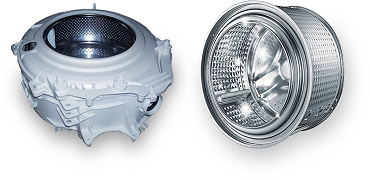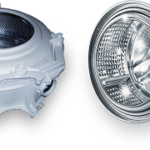 Hello! I would like to buy a washing machine, but I have a problem - I cannot decide on the choice of a drum. I heard that a steel drum is more durable than a plastic one. Plus, cracks may appear in plastic products even during transportation. At the same time, metal drum washing machines are much more expensive. Do I need to choose them and overpay? Also, what is the difference between a honeycomb drum and a regular one?
Hello! I would like to buy a washing machine, but I have a problem - I cannot decide on the choice of a drum. I heard that a steel drum is more durable than a plastic one. Plus, cracks may appear in plastic products even during transportation. At the same time, metal drum washing machines are much more expensive. Do I need to choose them and overpay? Also, what is the difference between a honeycomb drum and a regular one? First, I propose to understand the basic terms. The drum is a container in which the laundry is washed. Just it can be seen if you open the door or lid in the washing machine. Since it is made in all cases from stainless steel, there are no options here. However, there is also a tank - a container in which the drum is placed. It is into it that water with detergents is directed, which then goes through special slots into the compartment with laundry. Just the tank is made of plastic and stainless steel.
![]() See also - Which company is better to choose a washing machine
See also - Which company is better to choose a washing machine
What should be preferred?
More recently, manufacturers have offered washing machines with enameled tubs installed in them. At the same time, their service life turned out to be quite short: it was enough for a small crack to appear on the enamel surface for rust to appear on the metal in this place. Because of this, many manufacturers of washing machines made a difficult decision - refusing to install such tanks. As a result, they began to install plastic or steel tanks in their household appliances.
To figure out which one should be preferred, let's compare the pros and cons in the merged table:
| Stainless steel parts | Plastic parts | ||
| pros | Minuses | pros | Minuses |
| The most significant service life (high-quality steel will last up to 100 years) | In a washing machine with a metal tank, the water cools faster | More acceptable cost | Will last less time and require earlier replacement of the part |
| Resistance to chemicals used during washing (the metal tank will not fail either from detergents or from the use of descaling agents) | You should select a washing machine with high quality steel, because inexpensive steel loses its performance more quickly | Plastic provides better heat retention, i.e. less energy consumption during washing | |
| High cost | Good plastic will last about 20-25 years (i.e. its service life is similar to that of the washing machine itself) | ||
| High levels of noise and vibration | Low noise and vibration | ||
Thus, it will not work to say unequivocally what should be preferred. Indeed, in favor of each material, you can give your reasons. However, stainless steel products and plastic parts have their own disadvantages. Therefore, sometimes manufacturers of washing machines (for example, ARDO) choose a compromise solution and make the back of the tank from stainless steel, and the sides are made of plastic. Thus, it turns out to reduce the disadvantages of both materials and get the advantages of using each of them. The cost of manufacturing washing machines is also reduced from this.
Attention! "Plastic" in our case should be considered all variations of composite materials used in the production of tanks. This is due to the fact that many manufacturers are creating new versions of materials for the manufacture of tanks, which receive a brand name (for example, fibran, polynox, carbotech, etc.). There are few fundamental differences between them, but at the same time all manufacturers strive to offer something original.
In the event that your washing machine will not often be transported from one place to another, you can opt for a machine with a plastic tank. However, in addition to the material, we recommend that you take into account first of all other important characteristics. For example, the volume of consumed water and electricity.
Feature of honeycomb drums
In order to answer your second question - what is the difference between a honeycomb drum and a regular one - let us clarify one important point. The honeycomb drum is a Miele patented development. In this regard, other brands of washing machines are not equipped with them. The manufacturer claims that the drum it offers is more gentle on laundry, helps to reduce energy costs and has a longer service life.
In a washing machine, the inside of the laundry container contains hexagonal holes that resemble a honeycomb. Due to their concave structure, a small water film is formed between the laundry and the drum during the washing process, which protects the clothes during washing. In addition, there are no welded components in the interior (the most vulnerable points). Accordingly, the service life becomes significantly longer.
Naturally, parts made from high quality stainless steel are a more reliable solution compared to plastic counterparts of any type. However, can you appreciate 100 years of trouble-free operation of the tank? We believe that this is the case when you can talk about "excess quality". When choosing a washing machine, be guided first of all by its technical characteristics, stopping at the model that suits you completely. And only then look at the materials from which her tank is made.

